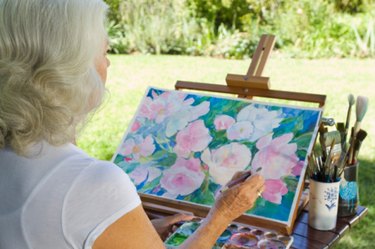Things You'll Need
Tarp
Bread
Soft-bristle brush

Watercolor paintings are much more fragile than oil paintings because oil paint is more durable than watercolor paint. Oil paintings are painted on canvas, which is also much more durable than the special paper used for watercolor paintings. Watercolor paintings cannot be cleaned with a damp rag because the dampness will compromise the integrity of the paper as well as the paint itself. Art restorers use bread to clean dust, dirt and grime that builds up on the surface of a watercolor painting.
Step 1
Lay a tarp down on a workbench in a well-lighted area or take the tarp and painting outside on a sunny day. The process can be slightly messy, so cleaning the painting outside is a good choice.
Video of the Day
Step 2
Purchase two to three loafs of bread. The amount of bread depends upon the size of the watercolor painting. Some art restorers prefer sourdough bread but other types of bread work as well.
Step 3
Dab or gently rub the painting with the pieces of bread. The soft, doughy texture of the bread picks up the dust and dirt on the painting without harming the watercolor. Wipe the painting with a piece of bread. As the bread becomes dirty, replace it with a fresh piece. Continue until the watercolor is completely cleaned.
Step 4
Brush the painting with a soft-bristle brush to remove the excess bread crumbs. Examine the painting to make sure all the dirt and debris has been removed.
Tip
Protect watercolor paintings with a frame and glass cover. The frame and glass protects the painting from stains and dust.
Take the watercolor painting to an art restorer if it is stained. Attempting to clean the stains yourself may easily result in damaging the painting.
Video of the Day